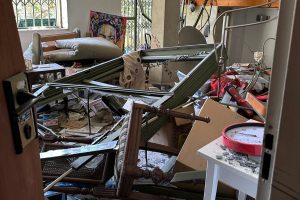The plaques at the AACI Memorial Forest near the Sha’ar HaGai Junction are inscribed with the names of more than 300 Canadians and Americans who have been killed in Israel, dating back to the 1920s, before the establishment of the Jewish state.
“There is a whole history of Canadians who have come here, or lived here, and died here,” said Donna Grushka, co-chair of the AACI Memorial Committee.
Among them, she names Polish-born Hashomer Hatzair activist Eliezer (Lulik) Krongold, who made aliyah from Toronto at age 21 (in 1935) and spent a year at Kibbutz America Banir in Hadera before moving on with his garin (group) to Juara in the spring of 1937. On April 7, 1938, when he was returning home from a day’s work plowing near Yokne’am, he was ambushed and killed along with his friend, Ephriam (Philip) Tiktin.
Then there is George (Buzzy) Buerling, who was born in Montreal in 1921 and served in the Royal Canadian Air Force as a fighter pilot during World War II. The decorated military hero then came to Israel in 1948 as a volunteer to help the fledgling Israeli Air Force. On May 20, 1948, he died in a plane crash near Rome, where he had been sent on a special secret mission by the Hagana.
Finally, Grushka told the story of Yehayahu (Sidney) Rubinoff, born in Toronto in 1926, who came to Israel to join the Palmach in January 1948, after his service in Europe with the Canadian army in World War II exposed him to survivors of the Holocaust.
“He was [allegedly] shocked by his encounter with the survivors, which awakened in him his Jewish identity,” Grushka said.
Rubinoff fought in the battles of Malchai, Ganei Yehoshua, and in Operation Dani to liberate Lod and Ramle. He was fatally wounded in the battle of Latrun and died on the way to hospital on July 17, 1948, at the age of 22.
The AACI adds names of people who have died in the past to Memorial Forest plaques if information about them surfaces and there is significant evidence to support their stories.
The organization is currently trying to get to the bottom of one case, a Canadian named David Bar, who was reportedly killed in the Golan Heights in 1974. “That’s all the information we have. We were never able to get very far with this story,” said Grushka, who has searched in all relevant archives in Israel, to no avail.
So far, only one source, from Ottawa, has come forward. More details are needed, both to corroborate the story and to learn more about what happened. “I’m afraid until now it has remained a mystery,” she said.
Anyone with information about David Bar, is asked to e-mail Judy Ann Cohen at [email protected]; call 972-2-566-1181; fax 972-2-566-1186, or write AACI, P.O.B. 4394, Jerusalem 91043, Israel.






